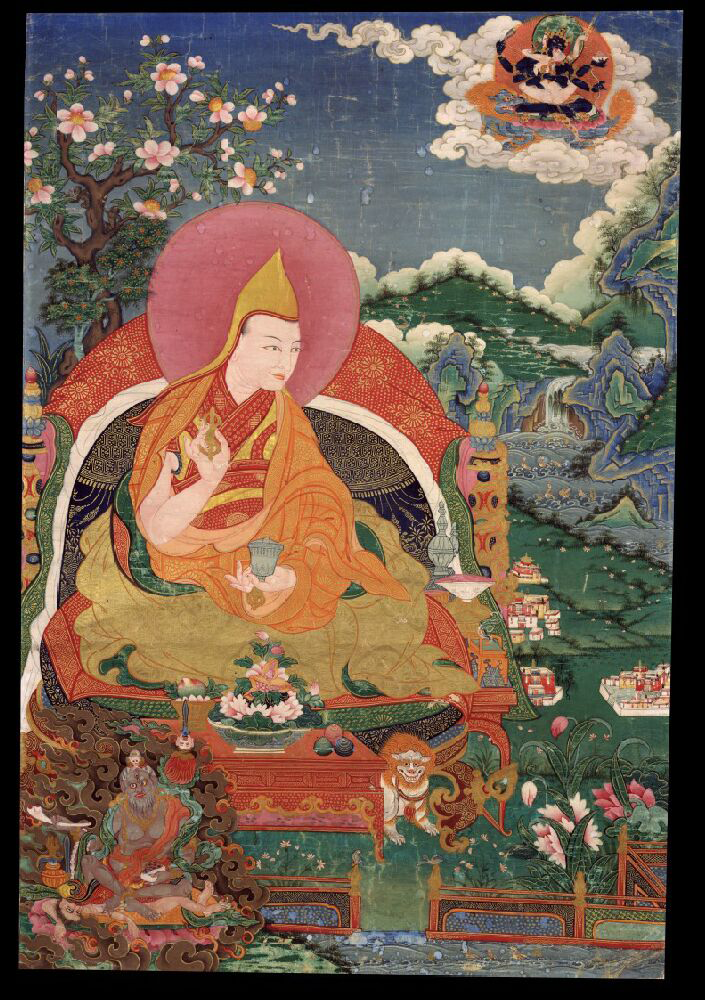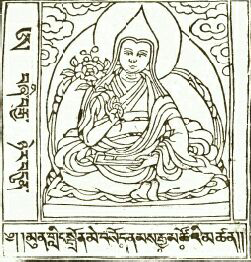Biography and autobiography in Tibet are important sources for both education and inspiration. The authors involved in the Treasury of Lives mine primary sources to provide English-language biographies of every known religious teacher from Tibet and the Himalaya, all of which are organized on their website. The following summarizes the biography of the Third Dalai Lama, Sonam Gyatso, by Miranda Adams.

Sonam Gyatso (1543–1588), the 3rd Dalai Lama, was the first individual endowed with the title. The name Dalai—given to Sonam Gyatso by Altan Khan (1507–1582), the leader of the Tumut Mongols and a descendent of Kublai Khan—is Mongolian for “vast sea.” After travelling to Mongolia at the ruler’s invitation, Sonam Gyatso would spend much of his life there.
Negative omens that preceded Sonam Gyatso’s birth inspired his parents to give him the milk of a white nanny goat, earning him the curious name Ranusi Chopel Zangpo—“happy boy protected by goat’s milk.” From a young age, Sonam Gyatso demonstrated unusual interest in all things ritual, speaking to his parents and those around him of visions of buddhas and bodhisattvas. A local lama received a vision in which the young child was prophesied to be the incarnation of Avalokiteśvara, and from this point forward, his reputation spread. By the time he was two years old, rumors had spread that he was the reincarnation of Gendun Gyatso (1476–1542), a famous abbot of Drepung and Tashilhunpo monasteries. He took his novice vows with Paṇchen Sonam Drakpa (1478–1554), who gave him the name Sonam Gyatso Pelzangpo Tenpai Nyima Chok Tamche Le Nampar Gyelwa. In 1552, he was made abbot of Drepung, and five years later he became abbot of Sera as well. In 1564, at the age of 22, Sonam Gyatso took full ordination and gave his first teachings at Tashilhunpo Monastery.
Like his previous incarnation, Sonam Gyatso cultivated relations with members of ruling houses across Tibet. He founded a number of monasteries, the most well known being Namgyel monastery, later the personal monastery of the Dalai Lamas.
Sonam Gyatso’s greatest missionary triumph was his forging of a relationship with the Mongol leaders. Altan Khan, the leader of the Tumet Mongols, initially sent a delegation to Drepung in the early 1570s, inviting Geluk hierarchs to Mongolia, without success. A second delegation arrived in 1577, and successfully persuaded Sonam Gyatso to return with them.

In 1578, on his way to Mongolia, Sonam Gyatso stopped at the site of Tsongkhapa’s birth, where a monk named Rinchen Tsondru Gyeltsen had founded a small temple. Sonam Gyatso asked him to expand it, and in 1583 consecrated it as Kumbum Jampa Ling, a monastery that would grow to be one of the largest of the Geluk sect.
Upon meeting Altan Khan, Sonam Gyatoso agreed to enter into a “patron-priest” relationship modeled on that of Pakpa Lodro Gyeltsen (1235–1280) and Khubilai Khan in the 13th century. For Altan, patronage of the growing Geluk tradition was a way to recreate his forebears’ influence in Tibet; for Sonam Gyatso, the opportunity for Mongol support for his missionary work both inside and outside of Tibet (he had earlier spent time on the Amdo borderlands spreading the Geluk teachings) was extremely attractive. It was at this time that Altan Khan gave Sonam Gyatso the title, in Mongolian, of ghaikhamsigh vcir-a dar-a say-in cogh-tu buyan-tu dalai, meaning “wonderful Vajradhara, good, brilliant, commendable ocean,” subsequently shortened to Dalai Lama.
While still in Mongolia, Sonam Gyatso received an invitation from the Ming Emperor Wanli to visit Beijing—an offer he refused. On his return to Tibet he passed through Kham and founded Litang Chode, also known as Ganden Tubchen Chokorling, in 1580. (That monastery, which has been destroyed and rebuilt multiple times in centuries following, recently suffered a catastrophic fire.) The following year, the 12th abbot of Chamdo Jampa Ling, Jedrung Lhawang Chokyi Gyeltsen (1537–1604), invited Sonam Gyatso to assume the duties of abbot at the monastery, where he spent about six months teaching, giving transmissions, and revising the monastery’s codes before returning to Lhasa.
After Altan Khan died in 1582, Sonam Gyatso returned to Mongolia at the invitation of Altan’s son. There he spent time among the Odros Mongols, who he converted to Buddhism, and the Khalkha Mongols.
Sonam Gyatso passed away in 1588, in Mongolia, after a period of illness. His remains were interred at Kokekhota.

Follow the Dalai Lama lineage:
The 1st Dalai Lama | The 2nd Dalai Lama
Thank you for subscribing to Tricycle! As a nonprofit, we depend on readers like you to keep Buddhist teachings and practices widely available.